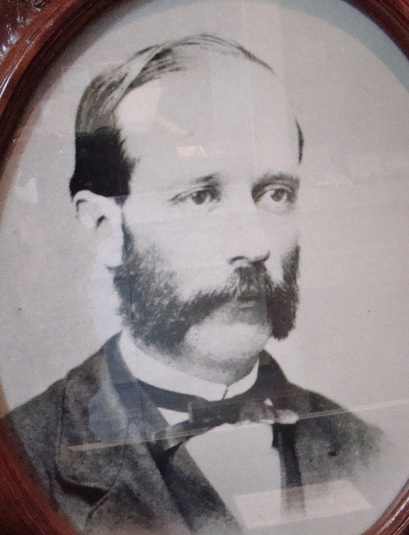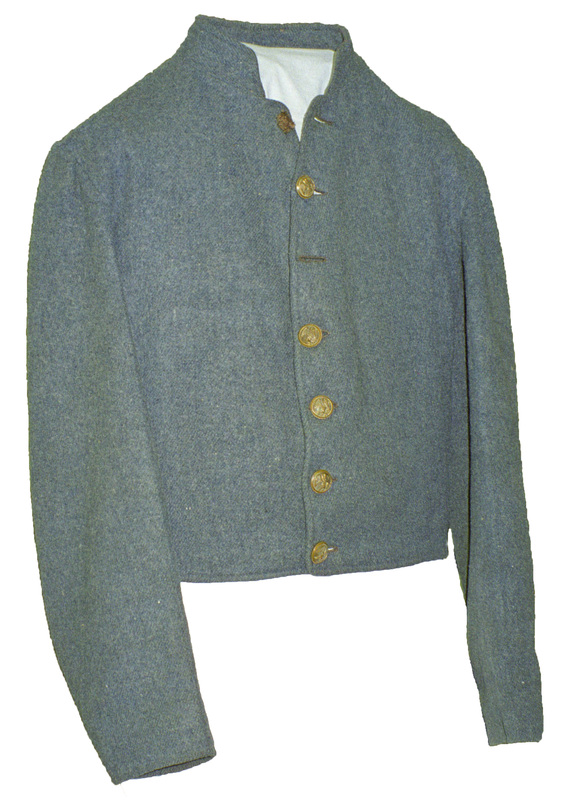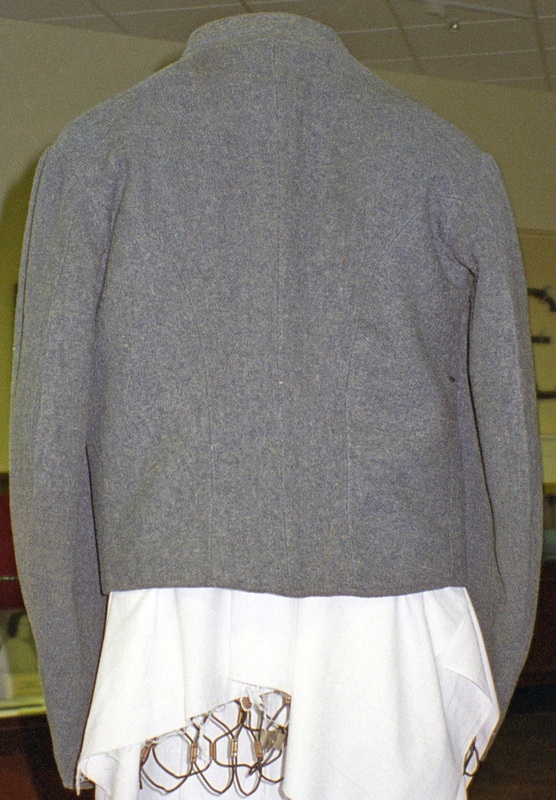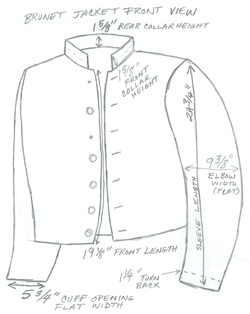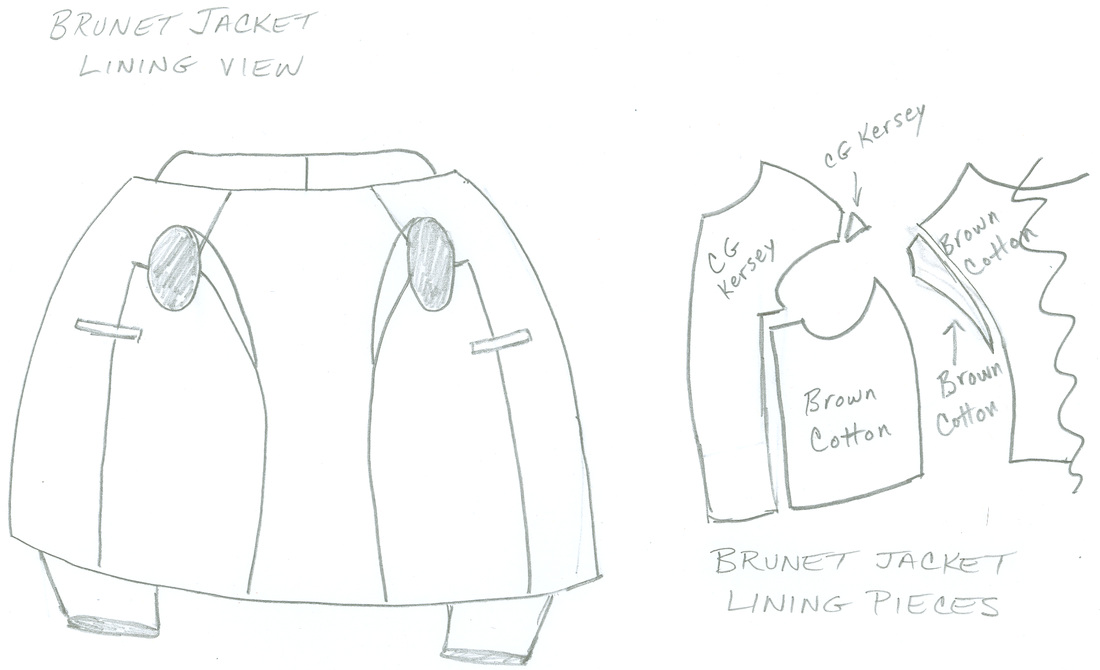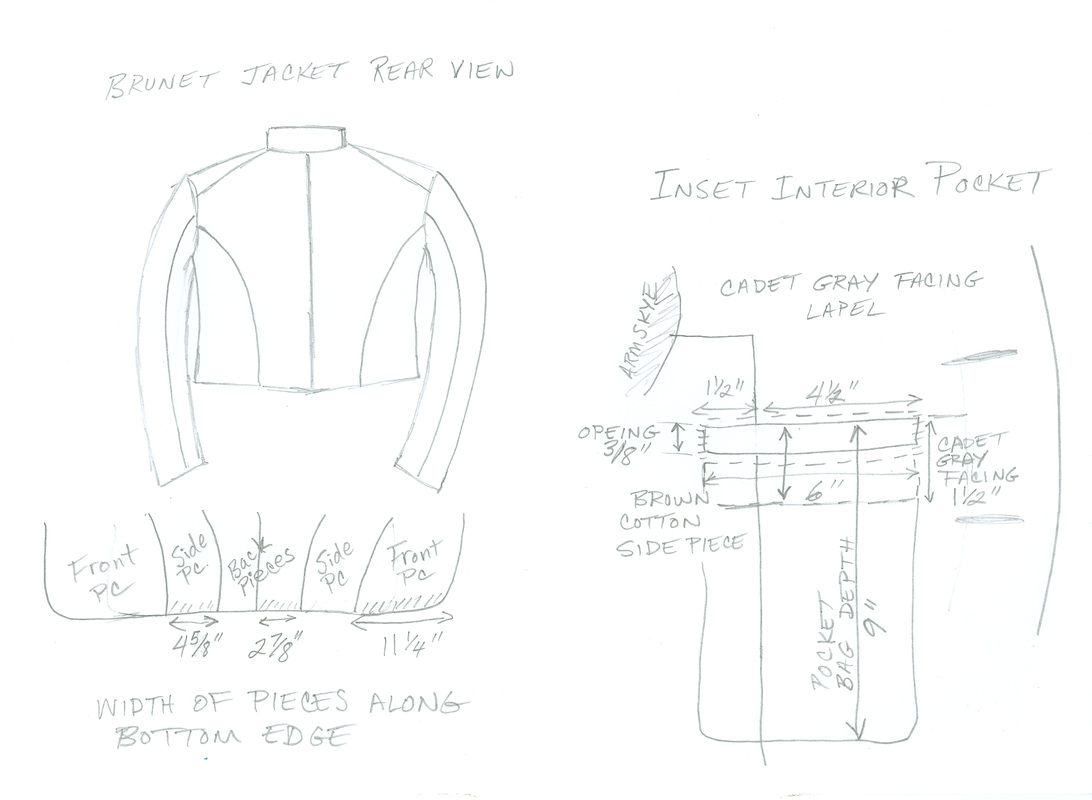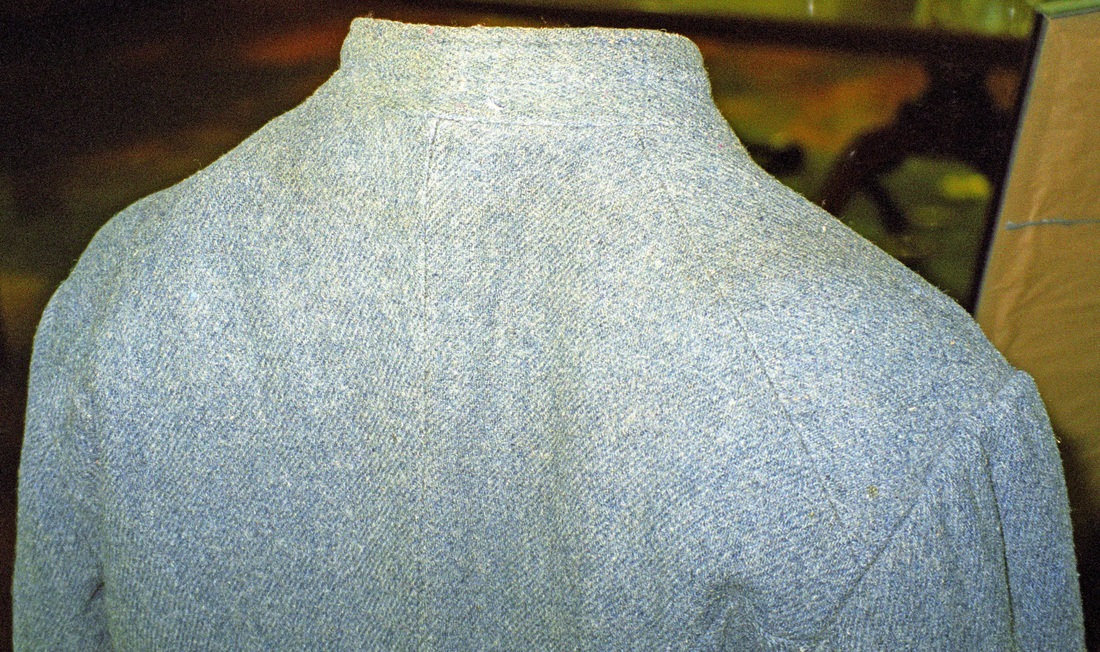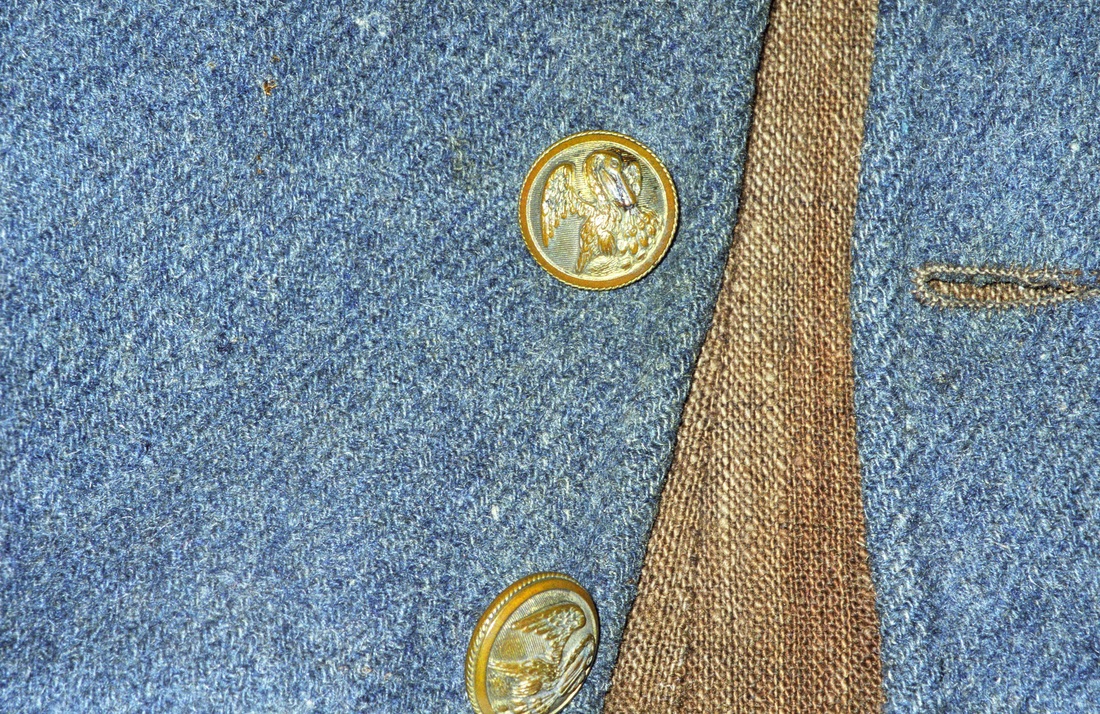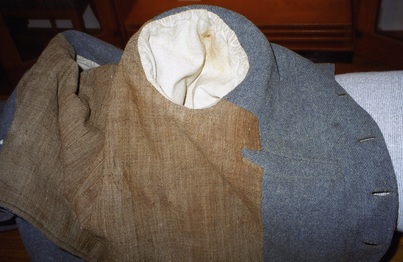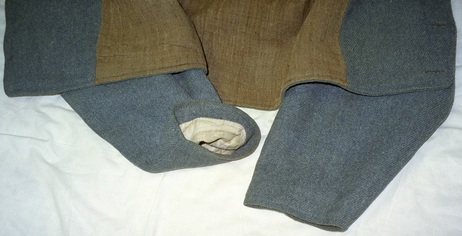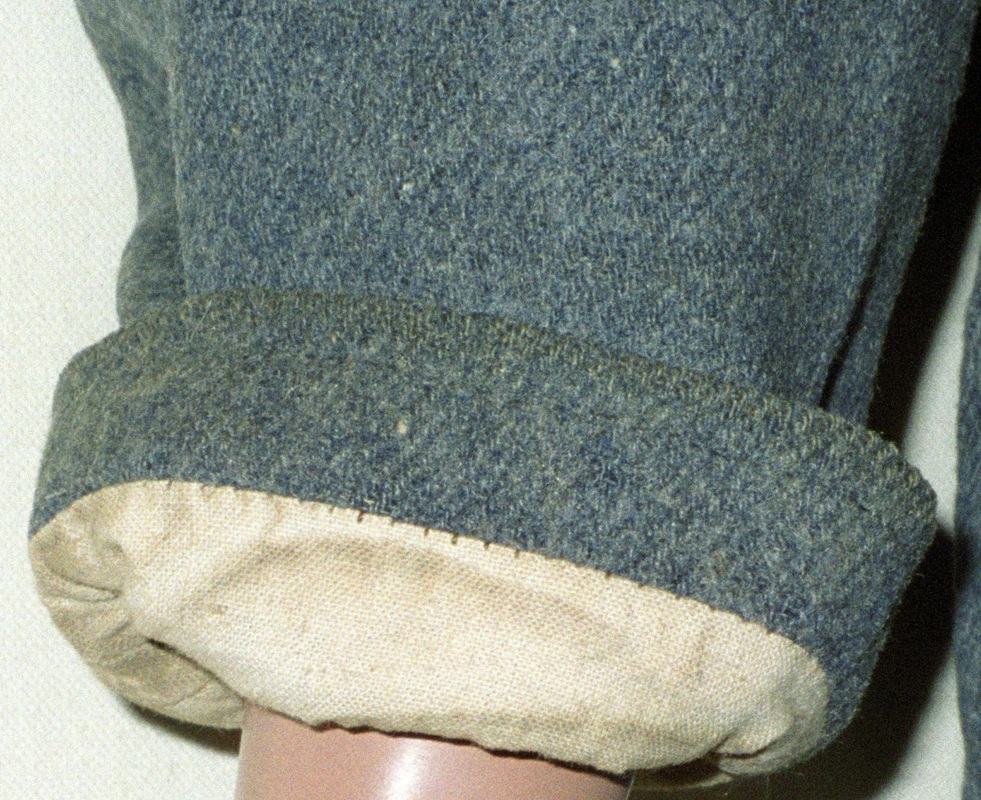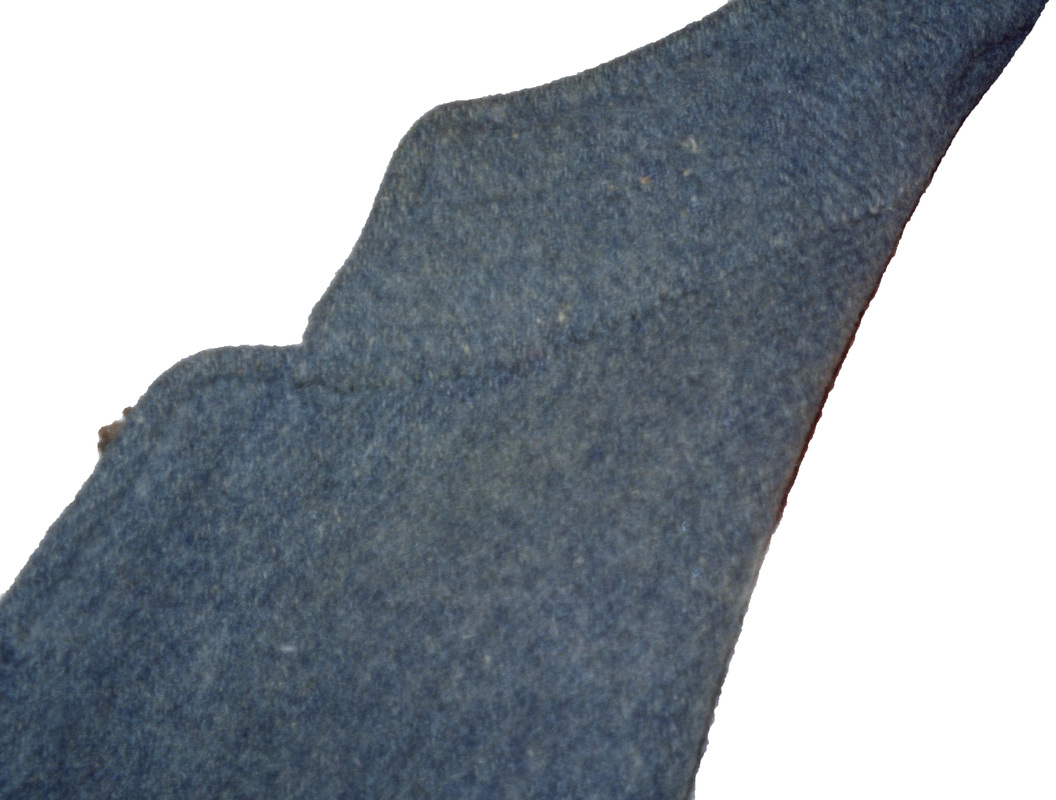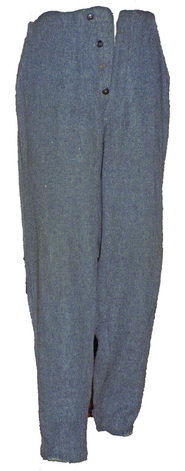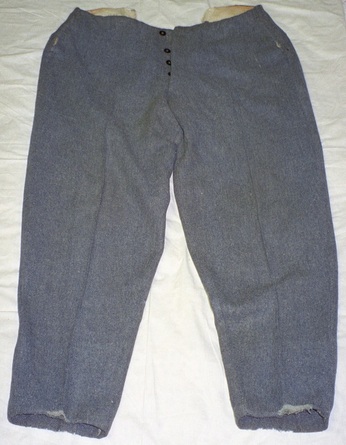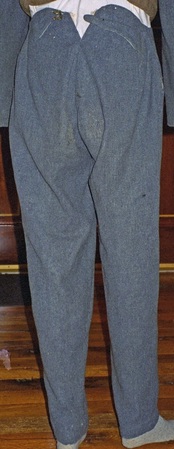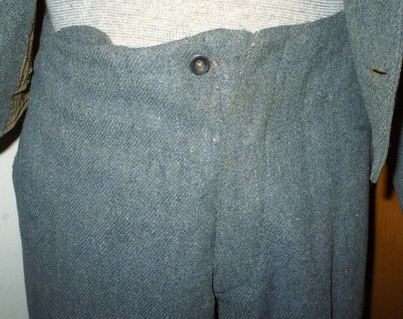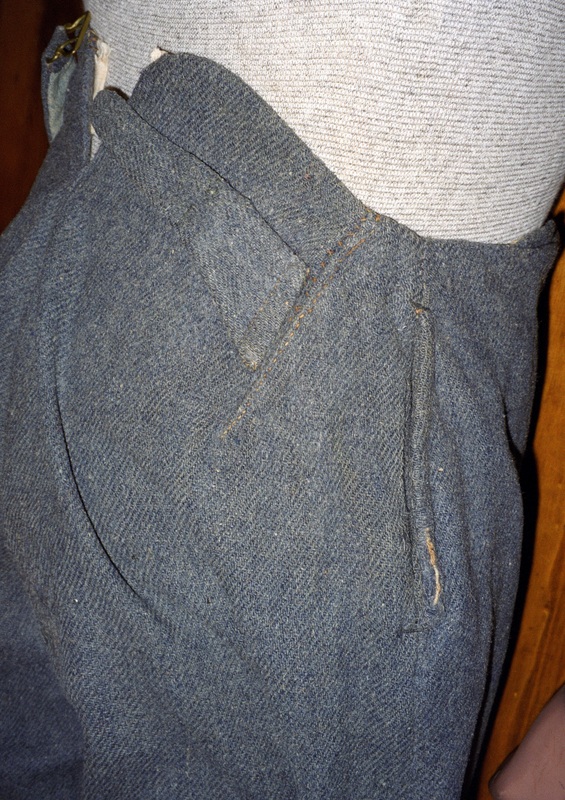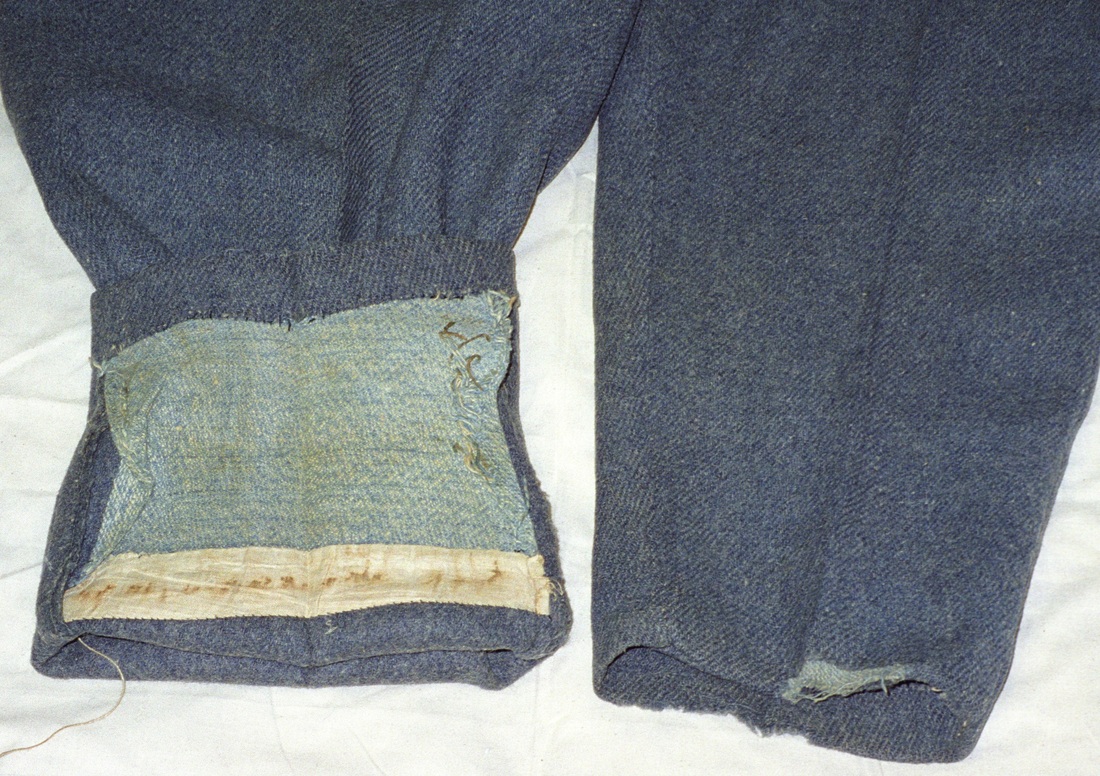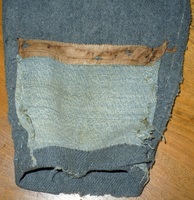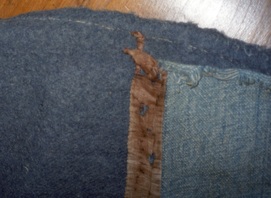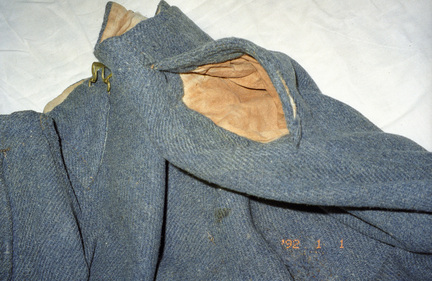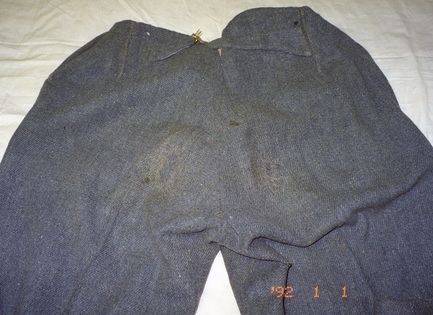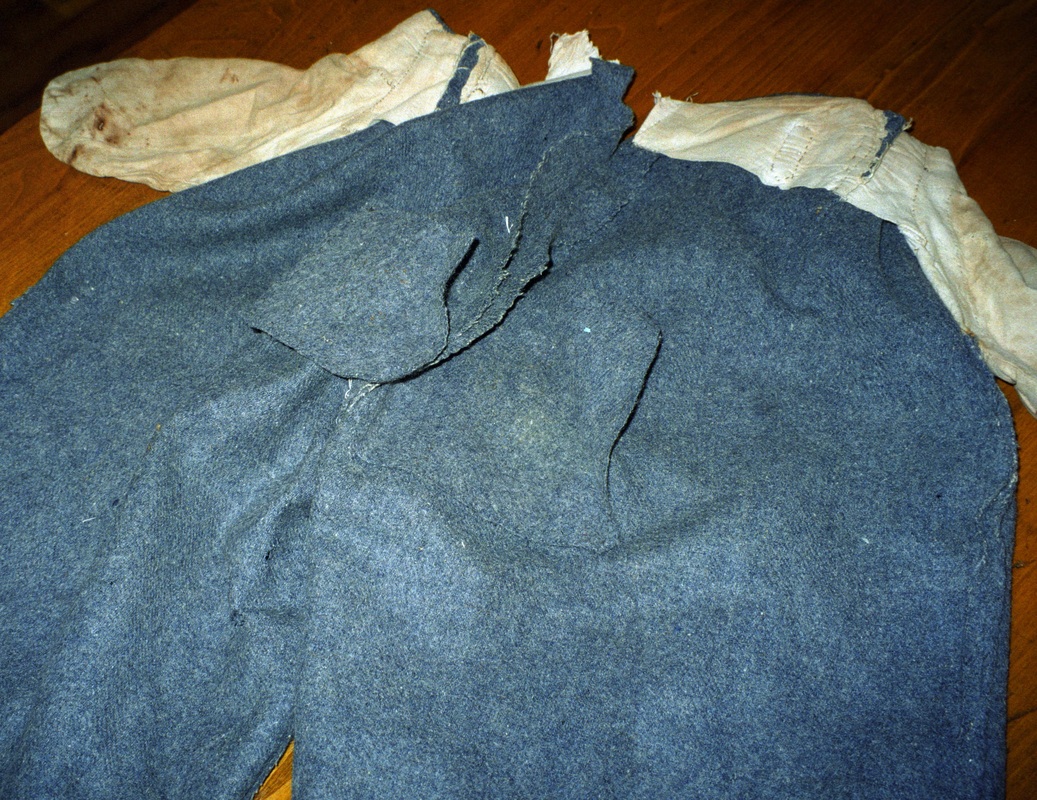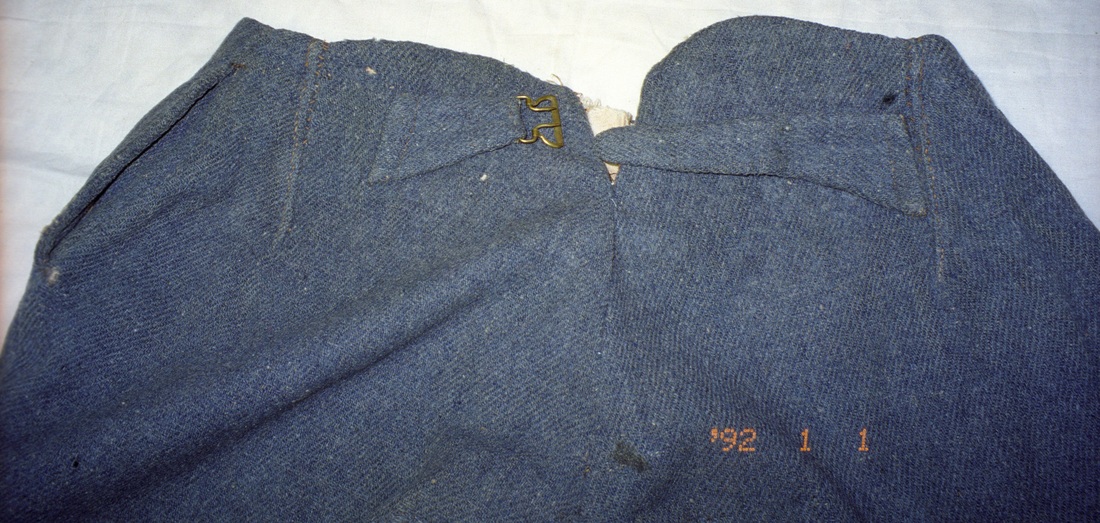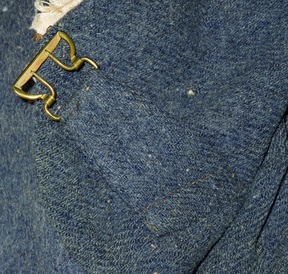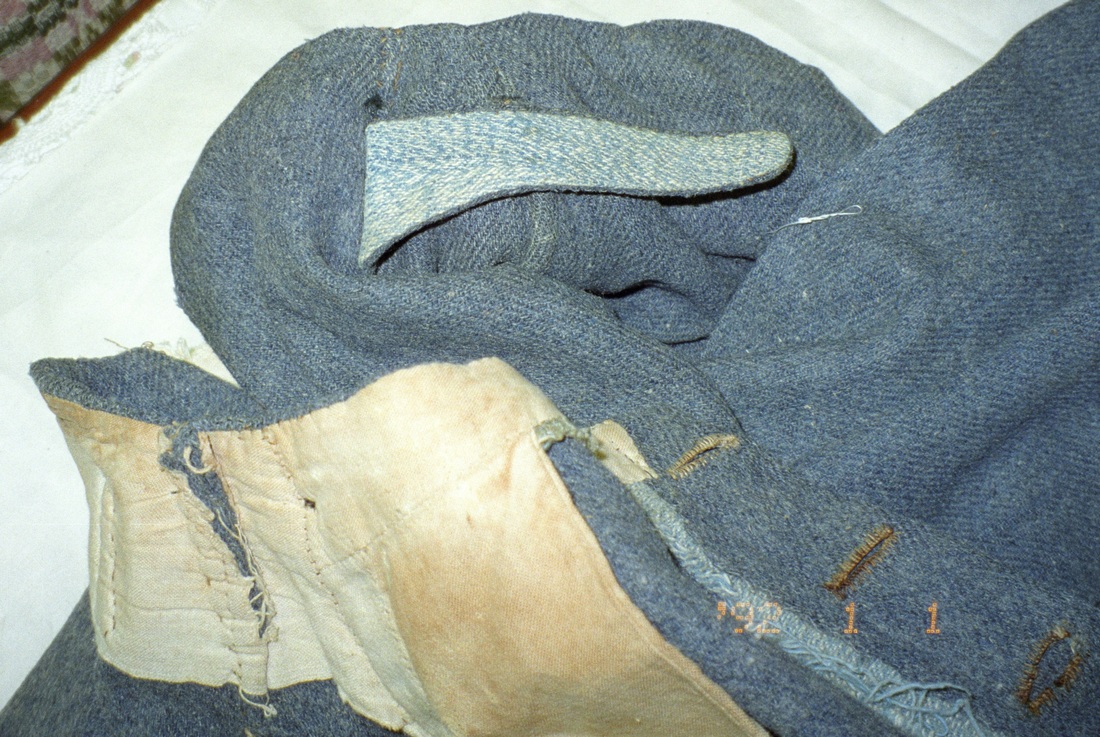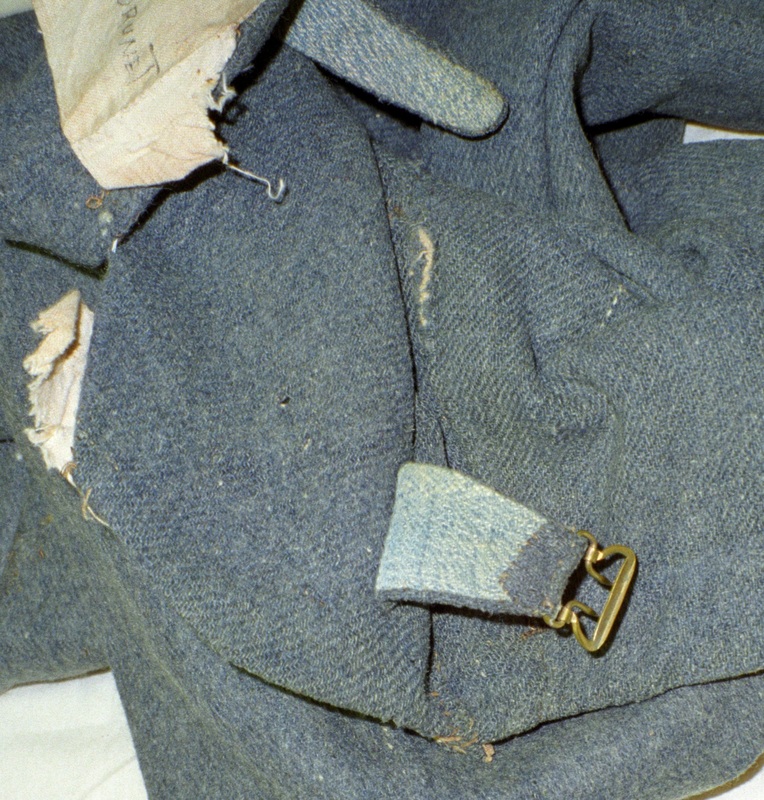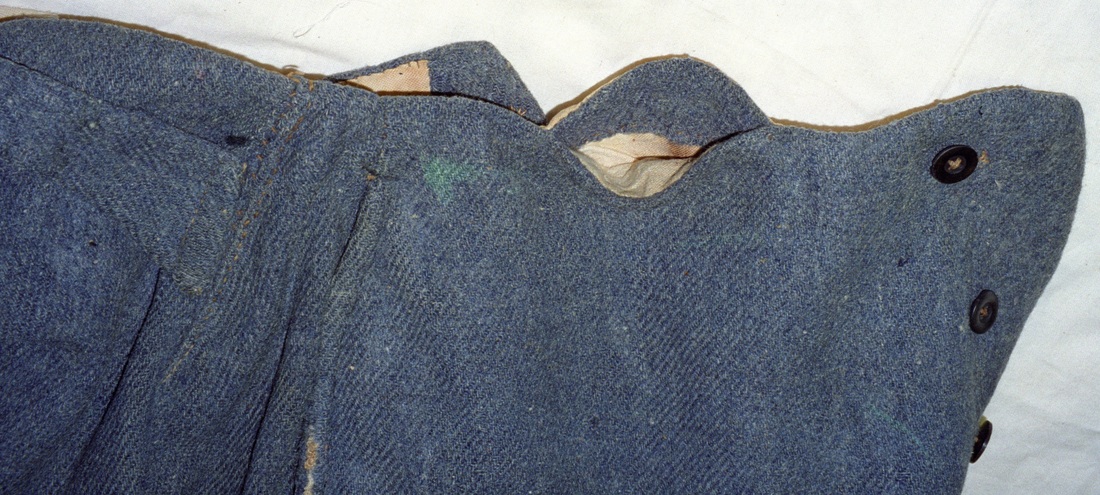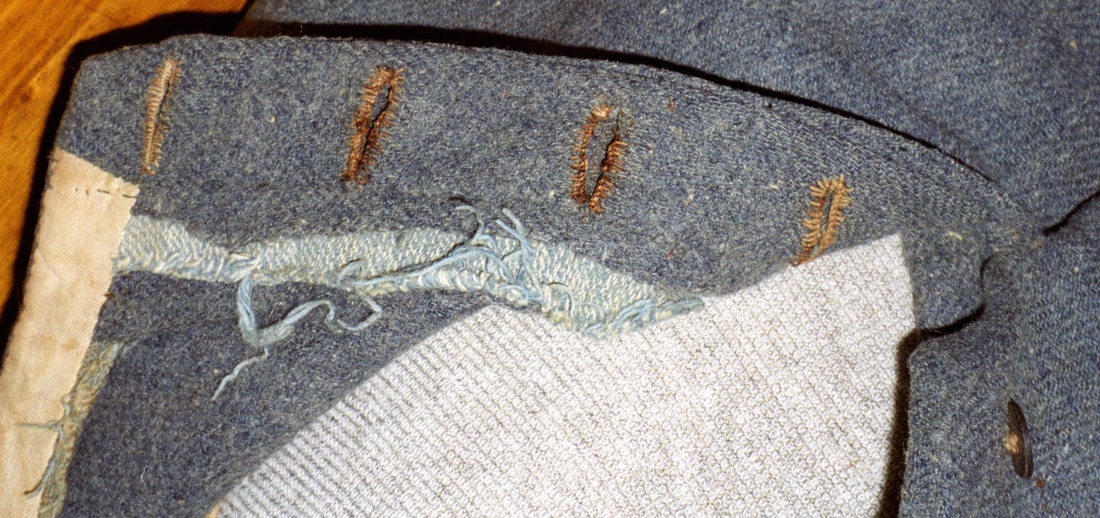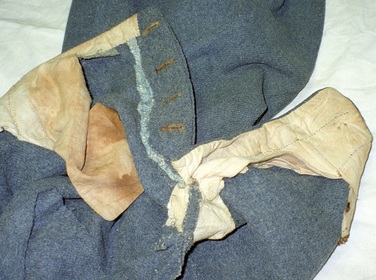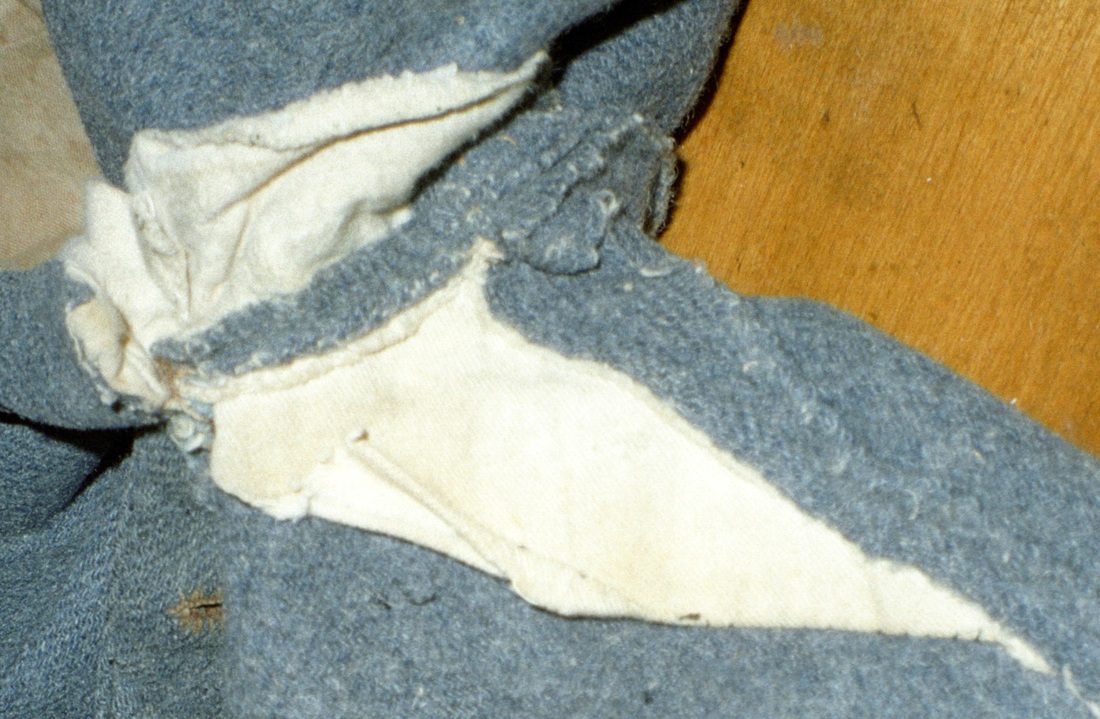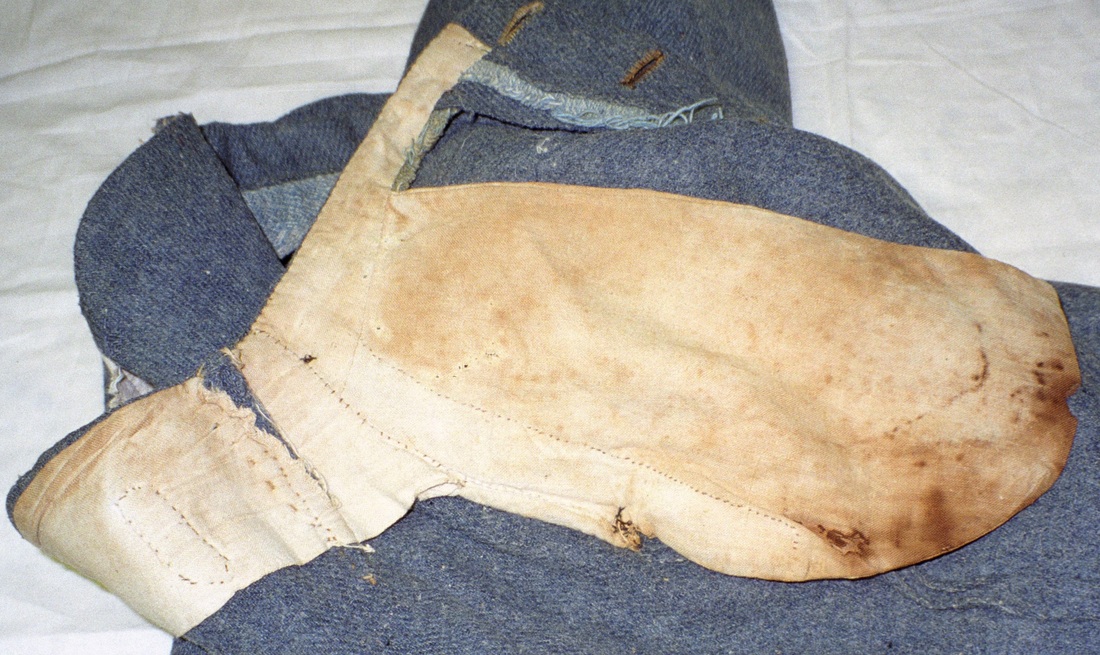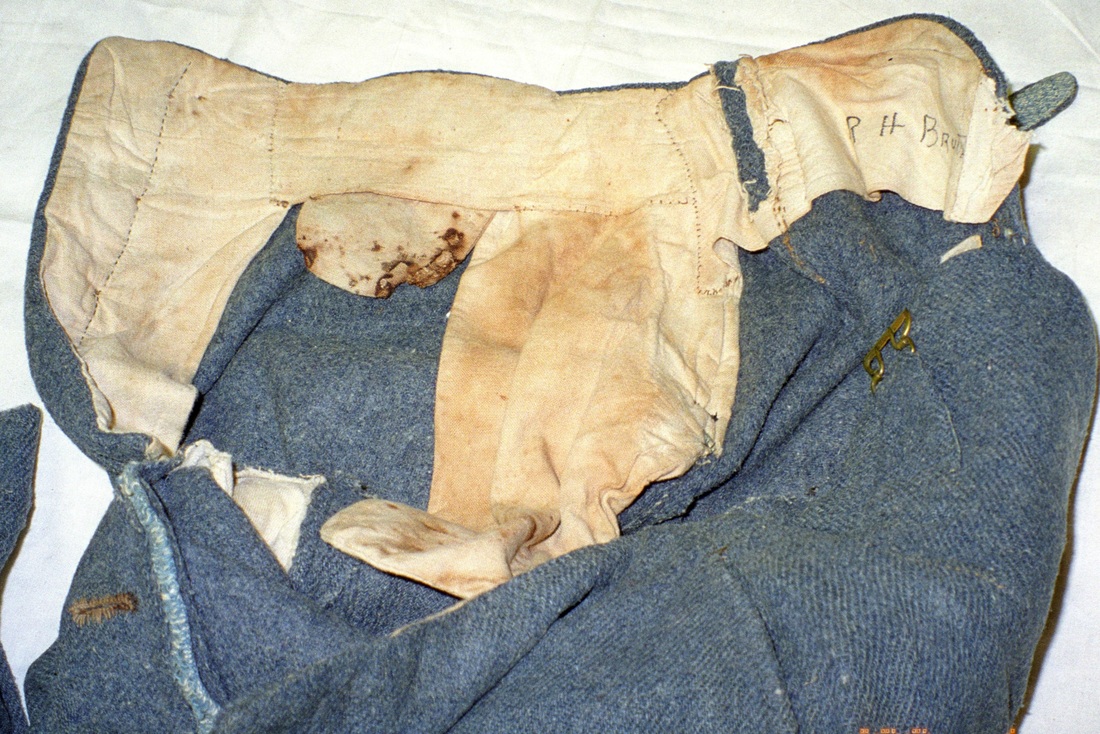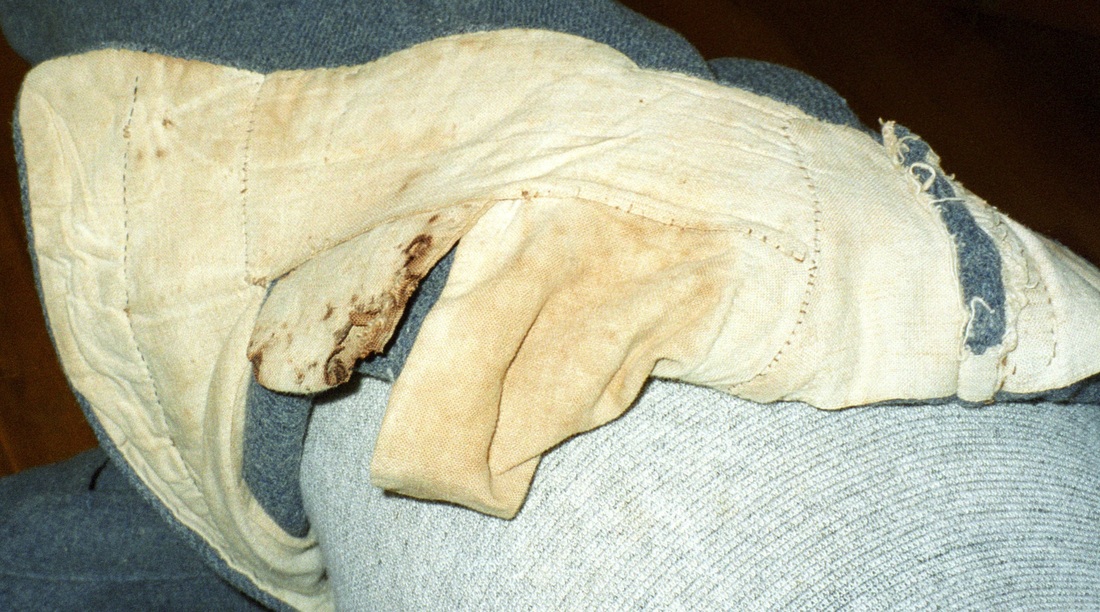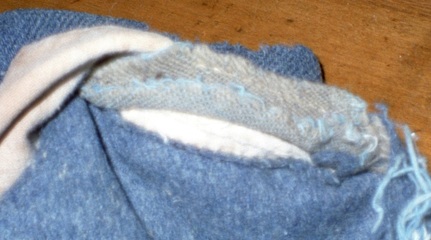Tailor-Made from Issued Cloth: Brunet’s Confederate
Uniform, Mobile 1864-65
By Fred Adolphus, 31 January 2014
The Museum of Southern History at Houston Baptist University houses a complete Confederate uniform of jacket and trousers, to include its provenance.[i] The uniform was worn by Private Rene Henry Brunet, Jr. of Fenner’s Louisiana Artillery. Brunet began his service in Rightor’s 1st Louisiana Infantry Battalion, which served in Pensacola and Virginia. The battalion’s term of enlistment expired in April of 1862 and the battalion disbanded on May 1st. Many of the men reenlisted in Fenner’s Battery, organized on May 16, 1862 in Jackson, Mississippi. The battery served at Port Hudson and in eastern Mississippi during the Vicksburg campaign. It moved to Mobile for a few months before joining the Army of Tennessee at Dalton in December 1863. It fought in the Atlanta and Tennessee campaigns. Following the retreat out of Tennessee, Fenner’s Battery had to destroy some of their guns, and transferred the rest to another battery. They then reported to Mobile and served as heavy artillery until the city fell to the enemy. The battery rearmed itself as infantry and marched to Meridian, Mississippi, where they were paroled on May 10, 1865.[ii] Brunet wore this cadet gray uniform at the end of the war.
Brunet’s uniform is not a depot product, but rather a suit made by a private source.[iii] Brunet’s command was issued a quantity of cadet gray cloth in Mobile that the Confederate quartermaster purchased from the Alabama State quartermaster in late 1864. The State of Alabama had purchased the cloth from Britain, and had a surplus that enabled them to sell part of their stock to the Confederate authorities.[iv] The commands that received this cloth would either have issued it directly to the individual soldiers, or turned it over in bulk to a contractor to have made into large lot of jackets and trousers. If the soldier received an allotment of cloth, he would have had his uniform made up on his own. In any case, the individual soldiers would have signed for an allotment of material and had the cost of the fabric deducted from their clothing allowance and pay. Some evidence suggests that Brunet’s uniform was made by a local tailor rather than by a government shop or private factory. To start with, there was no government clothing manufactory in Mobile.[v] Furthermore, the cadet gray jacket of another soldier of the same command, J. William Noyes, has survived and allows a comparison. Noyes’ jacket is entirely different from Brunet’s in its construction and materials. Neither jacket appears to have been factory made.[vi] These differences indicate that both soldiers found different private tailors and had their suits made up individually, rather than the brigade having had a bulk quantity of uniforms made by a single contractor. Brunet’s uniform would have made in late 1864 or early 1865, and worn during that period.
Brunet’s uniform is not a depot product, but rather a suit made by a private source.[iii] Brunet’s command was issued a quantity of cadet gray cloth in Mobile that the Confederate quartermaster purchased from the Alabama State quartermaster in late 1864. The State of Alabama had purchased the cloth from Britain, and had a surplus that enabled them to sell part of their stock to the Confederate authorities.[iv] The commands that received this cloth would either have issued it directly to the individual soldiers, or turned it over in bulk to a contractor to have made into large lot of jackets and trousers. If the soldier received an allotment of cloth, he would have had his uniform made up on his own. In any case, the individual soldiers would have signed for an allotment of material and had the cost of the fabric deducted from their clothing allowance and pay. Some evidence suggests that Brunet’s uniform was made by a local tailor rather than by a government shop or private factory. To start with, there was no government clothing manufactory in Mobile.[v] Furthermore, the cadet gray jacket of another soldier of the same command, J. William Noyes, has survived and allows a comparison. Noyes’ jacket is entirely different from Brunet’s in its construction and materials. Neither jacket appears to have been factory made.[vi] These differences indicate that both soldiers found different private tailors and had their suits made up individually, rather than the brigade having had a bulk quantity of uniforms made by a single contractor. Brunet’s uniform would have made in late 1864 or early 1865, and worn during that period.
Brunet's jacket
has the following characteristics:
The fabric is coarse, enlisted grade, cadet gray (or blue gray) kersey. The front has seven button holes, and originally had seven Louisiana Pelican buttons (Tice LA223A1) with Horstmann & Allienn backmarks. The first and third buttons are now missing. The buttons attached to the right lapel with heavy brown cotton thread. The buttonholes on the left lapel are sewn with the same brown thread that attaches the buttons. The body is lined with a heavy, coarse, brown, tabby weave cotton cloth. The sleeves are lined with unbleached white, tabby weave cotton cloth. The lining has two inlet pockets of unbleached white, tabby weave cotton cloth. The sleeves are one-piece, and the exterior body is six-piece construction (two front; two side; and, two back pieces). The jacket has topstitching all around the edge, collar and cuffs. The topstitch thread is cadet gray. The collar has an additional horizontal row of topstitching around the middle. The collar is interlined with unbleached white cotton cloth. The exterior collar is of one-piece, and the interior collar facing is of two-piece construction. The interior collar facing is whip stitched to the body lining.
The interior construction is remarkable, having no front pieces. It consists of a single back piece (no vertical center seam),and two side pieces in brown cotton (or perhaps linen), and two very wide facing lapels in cadet gray woolen cloth. The side pieces join the lapel facings, which omits the front pieces. The facing lapels extend all the way back to shoulder seams at the top. Additionally, there are two cadet gray gores in the facing lapels at the shoulder seam, and two brown cotton gores in the back piece at each shoulder seam. It appear as if the tailor did not have enough fabric to fully cut out these pieces and had to resort to using scrap cloth to full in the pattern requirement. The inset pockets are faced with cadet gray cloth and cut horizontally through the facing lapel and side pieces. The top cadet gray facing shows 3/8” wide (total dimension 1 7/8” wide), the bottom cadet gray facing is 1 ½” wide. The pocket opening is 6” wide overall (4 ½” through the lapel piece and 1 ½” through the side piece). The overall depth is 9”.
The jacket’s dimensions include following: sleeve length 24 1/2”; width at elbow 9 3/8”; width at cuff opening 5 ¾”; the cuff facing is turned up into the sleeve 1 ¼”; the overall front length is 19”; the overall back length is 21 ½”; the collar height all around is 1 5/8”; the width of the back piece at the bottom edge is 2 7/8”; the width of the side piece at the bottom edge is 4 ½”; and, the width of the front piece at the bottom edge is 11 ¼”.
The fabric is coarse, enlisted grade, cadet gray (or blue gray) kersey. The front has seven button holes, and originally had seven Louisiana Pelican buttons (Tice LA223A1) with Horstmann & Allienn backmarks. The first and third buttons are now missing. The buttons attached to the right lapel with heavy brown cotton thread. The buttonholes on the left lapel are sewn with the same brown thread that attaches the buttons. The body is lined with a heavy, coarse, brown, tabby weave cotton cloth. The sleeves are lined with unbleached white, tabby weave cotton cloth. The lining has two inlet pockets of unbleached white, tabby weave cotton cloth. The sleeves are one-piece, and the exterior body is six-piece construction (two front; two side; and, two back pieces). The jacket has topstitching all around the edge, collar and cuffs. The topstitch thread is cadet gray. The collar has an additional horizontal row of topstitching around the middle. The collar is interlined with unbleached white cotton cloth. The exterior collar is of one-piece, and the interior collar facing is of two-piece construction. The interior collar facing is whip stitched to the body lining.
The interior construction is remarkable, having no front pieces. It consists of a single back piece (no vertical center seam),and two side pieces in brown cotton (or perhaps linen), and two very wide facing lapels in cadet gray woolen cloth. The side pieces join the lapel facings, which omits the front pieces. The facing lapels extend all the way back to shoulder seams at the top. Additionally, there are two cadet gray gores in the facing lapels at the shoulder seam, and two brown cotton gores in the back piece at each shoulder seam. It appear as if the tailor did not have enough fabric to fully cut out these pieces and had to resort to using scrap cloth to full in the pattern requirement. The inset pockets are faced with cadet gray cloth and cut horizontally through the facing lapel and side pieces. The top cadet gray facing shows 3/8” wide (total dimension 1 7/8” wide), the bottom cadet gray facing is 1 ½” wide. The pocket opening is 6” wide overall (4 ½” through the lapel piece and 1 ½” through the side piece). The overall depth is 9”.
The jacket’s dimensions include following: sleeve length 24 1/2”; width at elbow 9 3/8”; width at cuff opening 5 ¾”; the cuff facing is turned up into the sleeve 1 ¼”; the overall front length is 19”; the overall back length is 21 ½”; the collar height all around is 1 5/8”; the width of the back piece at the bottom edge is 2 7/8”; the width of the side piece at the bottom edge is 4 ½”; and, the width of the front piece at the bottom edge is 11 ¼”.
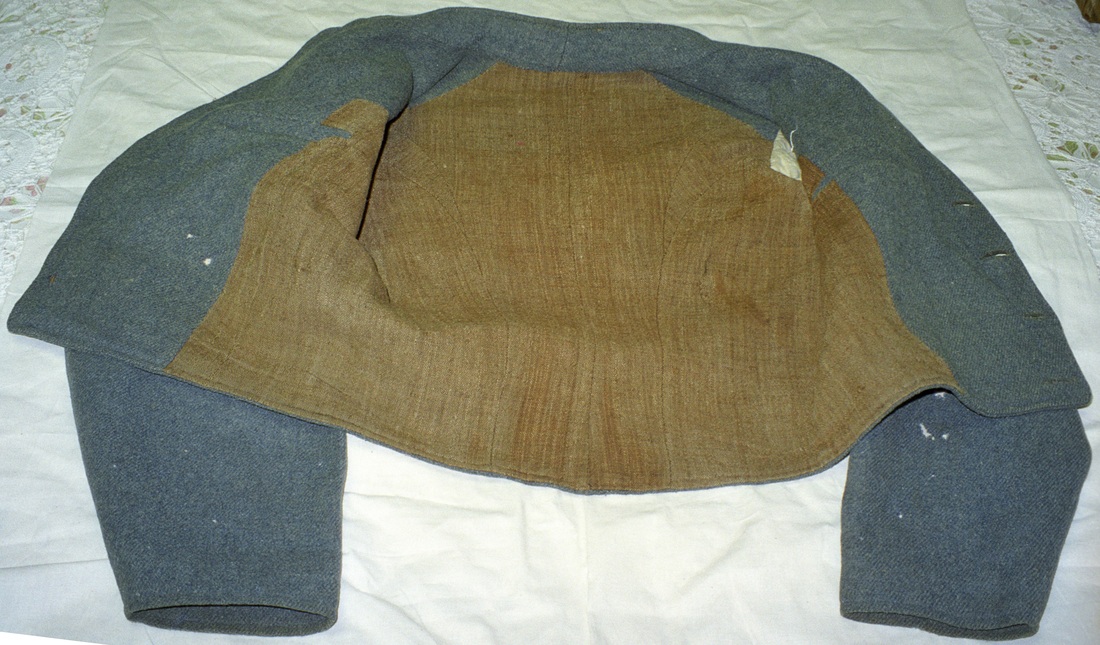
The body lining in Brunet's jacket is made from a plain weave fabric. It appears to be brown, nankeen cotton, but might also be linen. It has one back piece, two side pieces and two lapel facings, but no separate front pieces. Both the lining and the facing lapels are augmented with wedges of fabric. The jacket also has two interior, inset chest pockets.
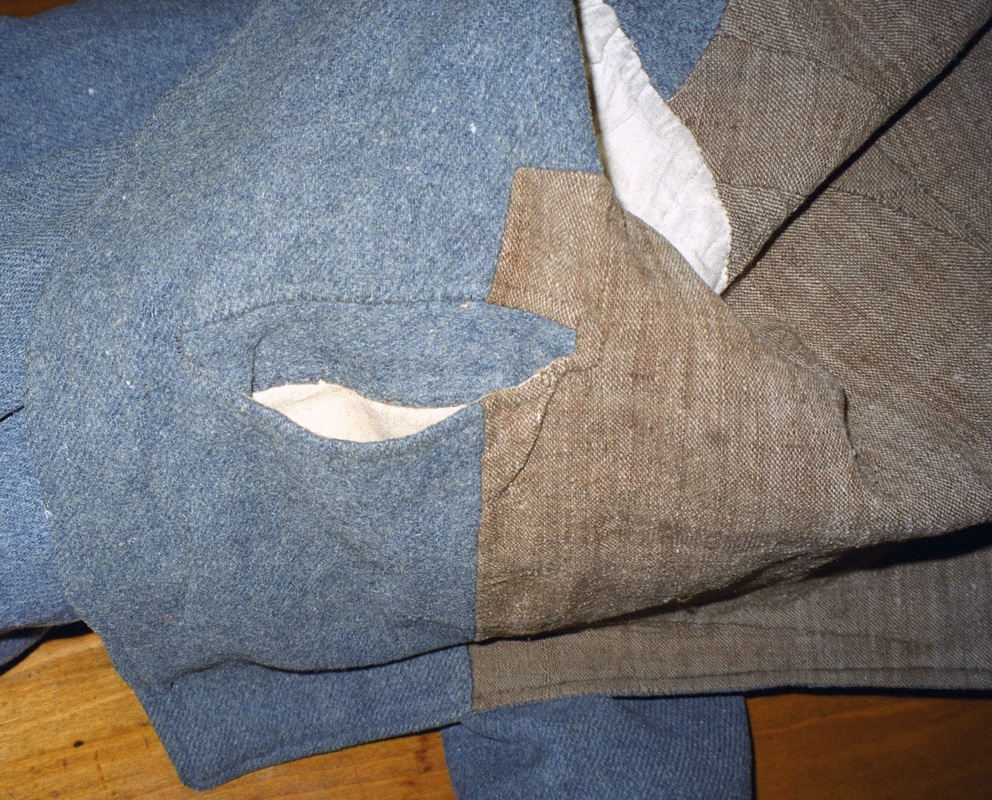
This close-up view of the lining shows the white cotton pocket bag; the small wedge of cadet gray cloth that augmented the facing lapel (above the brown cotton wedge); and, the odd, square corner tailored above the pocket opening. The square corner and the two wedges indicate that a tailor made the jacket since such characteristics are relatively uncommon in mass-produced uniforms.
Brunet's trousers
have the following characteristics:
The fabric is coarse, enlisted grade, cadet gray (or blue gray) kersey. The most salient feature of the trousers is the lack of a separate waistband from the leg pieces. The integral waistband is interlined with gray woolen-cotton jeans on one side and sky blue jeans on the other. The fly has four buttonholes and four black, 5/8” wooden, or horn buttons. The pants lining and pocket material consists of heavy, unbleached white, tabby weave cotton cloth. There are two side seam opening pockets, and an inlet watch pocket in the right waist band. The pockets open 1 1/4” from the top of the waistband with a 5 ½” opening. There is an adjustment belt at the rear seam that fastens with a yellow brass, suspender-style buckle. The buckle piece is on the left side and the tongue piece is on the right. The belt pieces are folded under on the ends where they are sewn to the back of the trousers. The reverse side of the belt is faced with sky blue jeans (either cotton or cotton and woolen) mentioned above, woven with white and sky blue threads. This same sky blue jeans material is used as facing in the buttonhole part of the fly and as linings in the cuffs. The left fly is faced on the inside with cadet gray kersey. The buttonhole flap has sky blue jeans on the inward, fly surface side, and cadet gray showing on the outward facing side. The trouser seat is very worn, but not worn through, and has interior rear seat area has patches basted over the thin spots. Furthermore, the waist was taken in after the pants were made in a very crude fashion. The rear panels were altered by simply cutting vertically through the waist seam, and sewing darts in place without finishing the edges: they are ironed down and left raw-edged. It appears to have been a “field modification” done by a soldier, not an experienced tailor. The interior front of each cuff is lined with sky blue jeans tucked into the turned up bottom edge, and whip stitched in place. The top of the sky blue lining is sewn in place with a strip of light weight cotton cloth. The cuff lining extends up from the bottom about 6 ½”. The crotch is lined, in the front leg pieces, with wedges of white cotton cloth. These pieces are sewn in place to the same seams that join all of the leg panels together. The pockets and waist seams are reinforced with bar tacks. For the most part, the pieces of the pants are joined with a quarter-inch seam allowance, but the rear seam, in the seat, has more than an inch of allowance at the top, gradually tapering to a quarter-inch.
The fabric is coarse, enlisted grade, cadet gray (or blue gray) kersey. The most salient feature of the trousers is the lack of a separate waistband from the leg pieces. The integral waistband is interlined with gray woolen-cotton jeans on one side and sky blue jeans on the other. The fly has four buttonholes and four black, 5/8” wooden, or horn buttons. The pants lining and pocket material consists of heavy, unbleached white, tabby weave cotton cloth. There are two side seam opening pockets, and an inlet watch pocket in the right waist band. The pockets open 1 1/4” from the top of the waistband with a 5 ½” opening. There is an adjustment belt at the rear seam that fastens with a yellow brass, suspender-style buckle. The buckle piece is on the left side and the tongue piece is on the right. The belt pieces are folded under on the ends where they are sewn to the back of the trousers. The reverse side of the belt is faced with sky blue jeans (either cotton or cotton and woolen) mentioned above, woven with white and sky blue threads. This same sky blue jeans material is used as facing in the buttonhole part of the fly and as linings in the cuffs. The left fly is faced on the inside with cadet gray kersey. The buttonhole flap has sky blue jeans on the inward, fly surface side, and cadet gray showing on the outward facing side. The trouser seat is very worn, but not worn through, and has interior rear seat area has patches basted over the thin spots. Furthermore, the waist was taken in after the pants were made in a very crude fashion. The rear panels were altered by simply cutting vertically through the waist seam, and sewing darts in place without finishing the edges: they are ironed down and left raw-edged. It appears to have been a “field modification” done by a soldier, not an experienced tailor. The interior front of each cuff is lined with sky blue jeans tucked into the turned up bottom edge, and whip stitched in place. The top of the sky blue lining is sewn in place with a strip of light weight cotton cloth. The cuff lining extends up from the bottom about 6 ½”. The crotch is lined, in the front leg pieces, with wedges of white cotton cloth. These pieces are sewn in place to the same seams that join all of the leg panels together. The pockets and waist seams are reinforced with bar tacks. For the most part, the pieces of the pants are joined with a quarter-inch seam allowance, but the rear seam, in the seat, has more than an inch of allowance at the top, gradually tapering to a quarter-inch.
Fred Adolphus studied this uniform on numerous occasions “through glass,” while
the uniform was on exhibit between 1986 and 2012. He examined the uniform minutely, “hands-on,”
for the first time in 1986. His most thorough
hands-on examinations followed on 14-15 November 1998; 23 December 1999; and, 17 July 2003.
He has taken copious photographs and
hand-written notes during each of these sessions.
Images courtesy of the Author, Museum of Southern History, Houston Baptist University, Houston, Texas.
Images courtesy of the Author, Museum of Southern History, Houston Baptist University, Houston, Texas.
Bibliography
[i] Museum of Southern History, Joella & Stewart Morris Cultural Arts Center, Houston Baptist University, Houston, Texas, Brunet jacket, pants and portrait.
[ii] 1st Special Battalion (Rightor’s) Louisiana Infantry & Captain Fenner’s Battery, Louisiana Light Artillery, R.H. Brunet, Jr., Compiled Service Records of Confederate Soldiers from the State of Louisiana, M320, Rolls 50 & 97; Captain Fenner’s Battery, Louisiana Light Artillery, J.W. Noyes, Compiled Service Records of Confederate Soldiers from the State of Louisiana, M320, Roll 50, War Department Collection of Confederate Records, Record Group 109, National Archives, Washington DC.
[iii] By 1864, there were two chief Confederate clothing depots (manufactories) in the Department of Alabama, Mississippi and East Louisiana. These were the combined Demopolis, Alabama and Columbus, Mississippi Depot, and the combined Selma and Montgomery, Alabama Depot. Furthermore, the State of Alabama operated its own depot in Montgomery. The aforementioned Confederate depots chiefly supplied CSA troops in the department at large, which included the garrison at Mobile, its largest consumer. The state furnished clothing to any Alabama soldiers, whether they were State Troops, Confederate, or officers. However, state production went mainly to the State Troops.
[iv] Official Records, War of the Rebellion, Series 4, Volume 3, pp. 1077-1078, Duff C. Green, Quartermaster General, State of Alabama to Brigadier General A.R. Lawton, Quartermaster General, CSA, Richmond, Virginia, February 10, 1865. General, Duff C. Green, offered to issue state-owned clothing supplies to Confederate troops if Confederate authorities would reimburse the State of Alabama for the costs. Green wrote a letter to Brigadier General A.R. Lawton, Quartermaster General, CSA, Richmond, Virginia dated February 10, 1865. Therein, he noted some of the prices for reimbursement as follows: gray and blue cloth at $7.50 per yard, flannel at $1.50 per yard, blankets at $10.00 each, and shoes at $10.00 per pair.
[v] The author has found no records substantiating either a Confederate or an Alabama State clothing depot at Mobile.
[vi] Confederate Memorial Hall, New Orleans, Louisiana, Noyes jacket.
[i] Museum of Southern History, Joella & Stewart Morris Cultural Arts Center, Houston Baptist University, Houston, Texas, Brunet jacket, pants and portrait.
[ii] 1st Special Battalion (Rightor’s) Louisiana Infantry & Captain Fenner’s Battery, Louisiana Light Artillery, R.H. Brunet, Jr., Compiled Service Records of Confederate Soldiers from the State of Louisiana, M320, Rolls 50 & 97; Captain Fenner’s Battery, Louisiana Light Artillery, J.W. Noyes, Compiled Service Records of Confederate Soldiers from the State of Louisiana, M320, Roll 50, War Department Collection of Confederate Records, Record Group 109, National Archives, Washington DC.
[iii] By 1864, there were two chief Confederate clothing depots (manufactories) in the Department of Alabama, Mississippi and East Louisiana. These were the combined Demopolis, Alabama and Columbus, Mississippi Depot, and the combined Selma and Montgomery, Alabama Depot. Furthermore, the State of Alabama operated its own depot in Montgomery. The aforementioned Confederate depots chiefly supplied CSA troops in the department at large, which included the garrison at Mobile, its largest consumer. The state furnished clothing to any Alabama soldiers, whether they were State Troops, Confederate, or officers. However, state production went mainly to the State Troops.
[iv] Official Records, War of the Rebellion, Series 4, Volume 3, pp. 1077-1078, Duff C. Green, Quartermaster General, State of Alabama to Brigadier General A.R. Lawton, Quartermaster General, CSA, Richmond, Virginia, February 10, 1865. General, Duff C. Green, offered to issue state-owned clothing supplies to Confederate troops if Confederate authorities would reimburse the State of Alabama for the costs. Green wrote a letter to Brigadier General A.R. Lawton, Quartermaster General, CSA, Richmond, Virginia dated February 10, 1865. Therein, he noted some of the prices for reimbursement as follows: gray and blue cloth at $7.50 per yard, flannel at $1.50 per yard, blankets at $10.00 each, and shoes at $10.00 per pair.
[v] The author has found no records substantiating either a Confederate or an Alabama State clothing depot at Mobile.
[vi] Confederate Memorial Hall, New Orleans, Louisiana, Noyes jacket.
